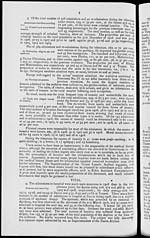Medicine - Mental health > 1903-1911 - Triennial report on the lunatic asylums in the province of Eastern Bengal and Assam > 1906, 1907, 1908 - Triennial report on the lunatic asylums in the province of Eastern Bengal and Assam for the years 1906, 1907, & 1908
(123) [Page 1]
Download files
Individual page:
Thumbnail gallery: Grid view | List view
![(9) [Page 1] -](https://deriv.nls.uk/dcn17/8316/83166668.17.jpg)
TRIENNIAL REPORT
ON THE
LUNATIC ASYLUMS
IN THE
PROVINCE OF EASTERN BENGAL AND ASSAM
FOR THE YEARS
1906, 1907 & 1908.
Introductory.
1. I held charge of the Lunatic Asylum at Dacca for the greater part of the trien-
nium under report and except when the following officers
officiated for me for the periods noted against their names :—
Major E. R. Parry, I.M.S., 27th June to 2nd October 1906, 16th to 18th June 1907.
Major A. R. S. Anderson, I.M.S., 19th June to 5th October 1907, 8th November to 31st
December 1907.
Lieutenant-Colonel E. A. W. Hall, I.M.S., 27th September to 31st December 1908.
Lieutenant-Colonel J. W. U. Macnamara, M.D., I.M.S., held charge of the Tezpur
Asylum from the commencement of the triennium to the 24th May 1907 and Major
H. S. Wood, I.M.S., from the latter date to the end of the triennium.
GENERAL.
Admissions.
2. The number of lunatics under confinement in both asylums on the 1st January
1906 was 425, while at the close of the triennium the
number was 486. The admissions (excluding re-admis-
sions) numbered 125, 95 and 108, respectively, in the first, second and third year of the
triennium, making a total of 328 against 284 in the previous triennium. The increase
in the number of admissions in the Dacca Asylum in 1906 was large, but this was due
to the fact that a number of criminal lunatics, who could not be moved from the Sylhet
Jail in 1905 owing to an out-break of beri-beri, were transferred to the Dacca Asylum in
1906. The districts of Dacca, Sylhet, Cachar and Mymensingh contributed the largest
number of the admissions to the Dacca Asylum, while to the Tezpur Asylum they came
mostly from Lakhimpur, Darrang, Sibsagar, Kamrup, Nowgong and the Khasi and
Jaintia Hills. The daily average strength of both asylums rose from 428.93 in 1905 to
480.33 in 1908.
Re-admissions.
The number of re-admissions was 22 in 1906, 9 in 1907, and 10 in 1908, or a total
of 41 against 31 in the previous triennium. Of these, 29
were criminals, who were returned to the asylums after
trial. Of the non-criminal lunatics, the majority were re-admitted after intervals of
several years, one being re-admitted in the Dacca Asylum 29 years after discharge.
Of the 10 re-admissions in 1908, 7 were criminal and 3 non-criminal lunatics.
Discharges.
The total number discharged was 69 in 1906, 52 in 1907, and 63 in 1908, or a total
of 184 against 211 in the previous triennium, the latter,
however, includes 20 lunatics transferred from the Dacca
to the Berhampur Asylum in 1904. Of 184 discharges, 140 were discharged cured
and 41 improved, and 3 not improved were made over to friends. The percentage
of recoveries to the daily average strength was lowest (5.95) at Dacca in 1907 and
highest (15.09) at Tezpur in 1906. Discharges among criminal lunatics numbered 30 in
1906, 18 in 1907 and 33 in 1908.
Escapes.
During the triennium there were 8 escapes, all from the Tezpur Asylum, against 2 at
Dacca and 4 at Tezpur in the previous triennium. Of these
8, two were re-captured and re-admitted to the Tezpur
Asylum.
Set display mode to: Large image | Zoom image | Transcription
Images and transcriptions on this page, including medium image downloads, may be used under the Creative Commons Attribution 4.0 International Licence unless otherwise stated. ![]()
| Permanent URL | https://digital.nls.uk/83166666 |
|---|




